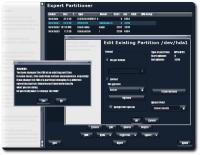Saturday, August 13th, 2005, 3:08 pm
Dual-Partition Linux
 arly this morning I made a bold move; it was bold for me, at least. I decided to make both partitions on my hard-drive adhere to the Reiser filesystem (FS), overwriting an unused Windows 2000 (NTFS) partition, which was rarely ever accessed. At times it was exploited as a storage area, yet no more than once month, which made it a complete waste of space.
arly this morning I made a bold move; it was bold for me, at least. I decided to make both partitions on my hard-drive adhere to the Reiser filesystem (FS), overwriting an unused Windows 2000 (NTFS) partition, which was rarely ever accessed. At times it was exploited as a storage area, yet no more than once month, which made it a complete waste of space.
Before formatting the NTFS partition, I was able to transfer data to the Windows partition using special tools. Linux can read NTFS, but not write to it, whereas Windows only understands its own filesystems (FAT, FAT32 and so forth) so there is no reciprocity. Nevertheless, there are tools which enable Windows users to read a Reiser filesystem, which is a common Linux filesystem.
They both require the user to boot into Windows, which is why I gave up on them and decided to stick to Linux partitions instead.

The moment of truth: so long Windows partition (click to enlarge)
To cut a long story short, I now have two Linux partitions, which I am extremely happy with. This move would not have been simple if it weren’t for the kind help from Houghi.
At an earlier stage I thought about installing Mac OS X on the new partition. Unfortunately, the process seems time-consuming, complicated and unreliable at its end. Moreover, it turned out that this had never been possible as Mac OS X (specifically the hacked version which runs on any machine) will not function under a partition, i.e. it requires a separate physical drive. To the curious, there are full instructions on how to installed Mac OS X on any standard PC. Many pictures and screenshots are included.






 Filed under:
Filed under: 